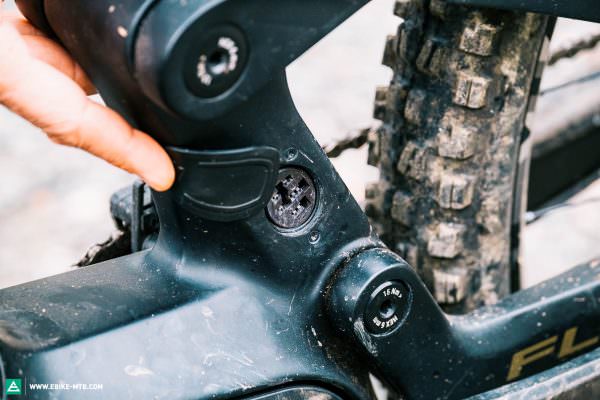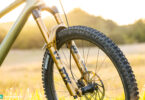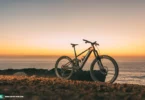For 2021, FLYER are taking a new approach to design and performance. With its elegant carbon frame and Bosch motor, the Uproc6 9.50 was designed with an eye toward downhill performance. But does that automatically make it the king of the park? And can it still assert itself as an all-rounder or is it too extreme?
For an overview of the test fleet head to the group test: The best eMTB of 2021 – 25 models in review

23.96 kg in size L | € 11,099 | Manufacturer’s website
The FLYER Uproc6 9.50 heralds a new era of bike design for the Swiss brand. The elegant carbon frame is burly, imposing and, above all, very classy. At the heart of FLYER’s € 10,999 bolide lies a Bosch Performance Line CX motor which is neatly integrated into the bike. Amongst the highlights is a massive, robust skid plate and a big 625 Wh battery, which similar to the Trek Rail can be removed from the side of the down tube – a clever feature that adds to the bike’s user-friendliness. The speed sensor is safely tucked away in the dropout and the corresponding magnet is neatly integrated into the rear brake rotor. Like CUBE, FLYER rely on an in-house holder for the Kiox display, placing this behind the handlebars right next to the stem. Moreover, the Swiss brand manages to avoid the unsightly Bosch vine by routing the chunky display cable neatly behind the handlebars, where it’s not visible for the rider. Not as neat is the standard Bosch charge port, which clashes with the otherwise high-quality look of the FLYER. If you’re using your bike daily, the cover won’t last long. All other frame details like the extensive seat- and chainstay protectors are well implemented and round off the overall high-quality package.
The spec of the FLYER Uproc6 9.50 is impressive
If we take a closer look at the spec, it becomes clear that FLYER are focussed on trail performance rather than saving grams. Hitting the scales at 23.96 kg, the Uproc comes equipped with a FOX 38 Factory GRIP2 fork and DPX2 shock, which grant a generous 170 mm and 160 mm travel respectively. A wireless SRAM X01 Eagle AXS drivetrain and RockShox Reverb AXS dropper-post (170 mm) ensure a relatively tidy cockpit while powerful MAGURA MT7 brakes with 220/200 mm rotors deliver reliable deceleration. For the brake levers, FLYER deliberately avoid the Shiftmix clamps in favour of ergonomics – this proved to be a great advantage compared to most other bikes with MAGURA brakes. The choice of wheels and tires is also spot-on: a DT Swiss HX 1501 alloy wheelset and MAXXIS tires with robust Doubledown casing. Unlike most bikes with mixed wheel sizes in the test, the Uproc6 comes with a 29 x 2.5″ ASSEGAI front tire in the soft 3C MaxxGrip compound and a narrow 27.5 x 2.5″ Minion DHRII at the rear.

FLYER’s in-house Kiox holder ensures a tidy cockpit. The Swiss deliberately avoid MAGURA’s Shiftmix clamps in favour of ergonomics.

The MAXXIS ASSEGAI front tire comes with the robust Doubledown casing and grippy 3C MaxxGrip rubber compound – this tire even sticks to damp roots. Excellent!

The massive skid plate forgives messy line choices and withstands hard rock impacts without batting an eyelid. Unfortunately, it doesn’t cover the whole Bosch drive unit.
FLYER Uproc6 9.50
€ 11,099
Specifications
Motor Bosch Performance Line CX 85 Nm
Battery Bosch PowerTube 625 Wh
Display Bosch Kiox
Fork FOX 38 Factory GRIP2 170 mm
Rear Shock FOX DPX2 Factory 160 mm
Seatpost RockShox Reverb AXS 125–170 mm
Brakes MAGURA MT7 220/200 mm
Drivetrain SRAM X01 Eagle AXS 1x12
Stem SPANK SPLIT 38 mm
Handlebar SPANK OOZY Vibrocore 780 mm
Wheelset DT Swiss HX 1501 29"/27.5"
Tires MAXXIS ASSEGAI/Minion DHF DD 2.5"
Technical Data
Size S M L XL
Weight 23.96 kg
Perm. total weight 130 kg
Max. payload (rider/equipment) 106 kg
Trailer approval no
Kickstand mount no

The integration of the Bosch system is almost perfect. Only the flimsy charge port casts a dark cloud over the otherwise high-quality impression. Other manufacturers, like CUBE, have implemented more elegant solutions.

The 625 Wh battery is well-secured in the down tube of the FLYER and never rattles. It can be removed from the side using an Allen key, which is hidden in the quick-release axle of the rear wheel and fits perfectly. We like it!

… except for the clunking of the motor. The generous seat- and chainstay protectors, as well as the successful cable routing, prevent chain slap and rattling cables. This way, the signature Bosch clunking noise will be the only background noise on the trail.
Having been launched only last summer, the Uproc6 9.50 is relatively new. Of course, this is also reflected in the geometry, which is accordingly modern yet balanced. The FLYER comes in four sizes, catering to riders between 1.55 m and 1.95 m tall. The relatively slack 64.5° head angle underlines the bike’s focus on downhill performance. However, the pronounced kink in the seat tube makes for a rather slack 75.3° seat angle, though here, this results in a balanced riding position with weight evenly distributed between your hands and seat. However, the angle slackens out even further as the dropper post extends, forcing riders with long legs far back over the rear wheel even on flat trails. While the FLYER doesn’t shy away from long tours, here it can get easily bored and feel underwhelmed.
| Size | S | M | L | XL |
|---|---|---|---|---|
| Seat tube | 395 mm | 415 mm | 450 mm | 485 mm |
| Top tube | 579 mm | 608 mm | 636 mm | 664 mm |
| Head tube | 100 mm | 100 mm | 105 mm | 110 mm |
| Head angle | 63.5° | 64.5° | 64.5° | 64.5° |
| Seat angle | 75.7° | 75.5° | 75.3° | 75.2° |
| Chainstays | 445 mm | 445 mm | 445 mm | 445 mm |
| BB Drop | 31 mm | 31 mm | 31 mm | 31 mm |
| Wheelbase | 1,208 mm | 1,223 mm | 1,250 mm | 1,277 mm |
| Reach | 420 mm | 445 mm | 470 mm | 495 mm |
| Stack | 623 mm | 629 mm | 633 mm | 638 mm |

Jersey Fox Ranger | Shorts Fox Ranger Shorts | Kneepad Fox Launch D3O
Socks Fox 8″ Trail Cushion | Gloves ION Path
Bike park ready! The FLYER Uproc6 9.50 on the trail
Uphill, the rear-heavy pedalling position is a limiting factor. However, compared to other bikes with a slack seat angle, the shock of the Uproc sits high in its travel even on steep climbs, making it easy to weight the front wheel. And that’s exactly what you’ll have to do if you want to keep the front wheel tracking, especially when negotiating tight corners. The robust rear tire allows for low air pressures and helps generate lots of traction, even when you have to get out of the saddle to prevent the front wheel from lifting on very steep and technical sections. Even then, the Uproc6 9.50 can’t keep up with the strongest climbers on test.
The FLYER doesn’t care how long the queue at the lift is because it prefers to get to the trailhead under its own power. It’s an absolute blast on man-made bike park trails!


Tuning tip: riders with long legs should push the saddle all the way forward
Downhill, the FLYER strikes as a balanced all-rounder. Despite the huge amounts of travel and massive reserves, it’s great fun on flowing trails. Not only does the suspension generate good traction but it also offers plenty of support, allowing you to build up speed in fast berms and making it easy to pop off ledges and jumps. However, that smooth and more placid character means the FLYER isn’t as much fun as the nimblest bikes on test. On technical singletracks, the Uproc6 9.50 generates good traction and rolls over obstacles easily and safely. That being said, playful and spontaneous manoeuvres like with the Lapierre, require a lot of physical effort and good riding technique to implement. It’s on rough, fast descents and man-made downhill tracks that the FLYER really comes to life: no jump is too big, no G-out too hard and no drop too high. With stoic smoothness and clinical precision, the Uproc6 9.50 stays true to your line.

Riding Characteristics
7Agility
- sluggish
- playful
Stability
- nervous
- stable
Handling
- demanding
- balanced
Riding fun
- boring
- lively
Motor feeling
- digital
- natural
Motor power
- weak
- strong
Value for money
- poor
- top
Conclusion
The FLYER Uproc6 9.50 does almost everything right! The burly carbon frame exudes quality and features countless clever details. If you spend most of your time shredding bike parks and hate the queues at the lift, you should take a closer look at the FLYER, as the spec and handling are nothing short of perfect for this purpose! Despite the strong downhill focus, it also handles moderate trails and long climbs well. Chapeau, FLYER!
Tops
- performance on rough and fast descents
- versatile despite the downhill-oriented concept
- build quality and spec
- good integration of the Bosch system
Flops
- standard Bosch charge port cover

You can find out more about at flyer-bikes.com
The test field
For an overview of the test fleet head to the group test: The best eMTB of 2021 – 25 models in review
All bikes in test: Cannondale Moterra Neo Carbon 1 (Click for review) | Canyon Spectral:ON CF 9 (Click for review) | CENTURION No Pogo F3600i (Click for review) | CUBE Stereo Hybrid 140 HPC SLT Nyon (Click for review) | CUBE Stereo Hybrid 160 C:62 SLT Kiox (Click for review) | Ducati TK-01 RR (Click for review) | FLYER Uproc6 9.50 | FOCUS JAM² 6.9 NINE (Click for review) | GIANT Trance X E+ 1 (Click for review) | Haibike AllMtn 7 (Click for review) | KTM Macina Kapoho Prestige (Click for review) | Lapierre Overvolt GLP 2 Team (Click for review) | MERIDA eONE-SIXTY 10K (Click for review) | Mondraker Crafty Carbon XR (Click for review) | Moustache Samedi 29 Trail 8 (Click for review) | ROTWILD R.X375 ULTRA (Click for review) | Santa Cruz Bullit X01 RSV Air (Click for review) | SCOTT Ransom eRIDE 910 (Click for review) | SIMPLON Rapcon PMAX (Click for review) | Specialized S-Works Turbo Levo (Click for review) | Specialized S-Works Turbo Levo SL (Click for review) | STEVENS E-Inception AM 9.7 GTF (Click for review) | Thömus Lightrider E2 Pro (Click for review) | Trek Rail 9.9 X01 (Click for review) | Whyte E-150 RS 29ER V1 (Click for review)

Relaxed and comfortable riding on surfaced roads, both uphill and downhill.↩
Easy climbs up trails with few obstacles, wide turns and a moderate incline.↩
Active and playful descents on easy trails with few obstacles, wide turns and a moderate slope.↩
Single-track climbs on challenging terrain. Loose ground, steps, roots, tight corners and occasionally extreme inclines.↩
Singletrack descents on challenging terrain. Loose ground, steps, roots, tight corners and small jumps as well as some very steep descents.↩
High speed descents on sometimes very rough trails with large jumps and obstacles that you can’t roll over.↩
The rating used for riding characteristics refers to the bikes in the group test and the current state of development of eMTBs. The best bikes managed to blend supposedly opposite riding characteristics, feeling both lively and stable at the same time. The handling describes the balance of the bike on downhill sections. The information regarding motor-power refers to the ride-feeling in the overall context of the bike and not exclusively to the motor – that’s why the same motor can present different values.↩
Did you enjoy this article? If so, we would be stoked if you decide to support us with a monthly contribution. By becoming a supporter of E-MOUNTAINBIKE, you will help secure a sustainable future for high-quality cycling journalism. Click here to learn more.
Words: Photos: Various









